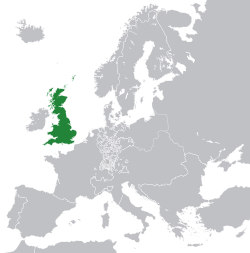Kingdom of Great Britain
|
Great Britain
Dutch: Groot Brittanië |
||||||||||||
|
||||||||||||
|
||||||||||||
|
Location of Great Britain in 1801 (green)
in Europe (green & grey) |
||||||||||||
| Capital |
London 51°30′N 0°7′W / 51.500°N 0.117°W |
|||||||||||
| Languages | English (official), Scots, Norn, Welsh, Cornish, Scottish Gaelic, Angloromani | |||||||||||
| Demonym | British, Briton | |||||||||||
| Government | Unitary parliamentary constitutional monarchy | |||||||||||
|
Monarch
Royal houses
|
||||||||||||
| • | 1707–1714 | Anne | ||||||||||
| • | 1714–1727 | George I | ||||||||||
| • | 1727–1760 | George II | ||||||||||
| • | 1760–1801 | George III | ||||||||||
| Prime Minister | ||||||||||||
| • | 1721–1742 | Robert Walpole | ||||||||||
| • | 1742–1743 | Spencer Compton | ||||||||||
| • | 1757–1762 | Duke of Newcastle | ||||||||||
| • | 1766–1768 | William Pitt the Elder | ||||||||||
| • | 1770–1782 | Lord North | ||||||||||
| • | 1783–1801 | William Pitt the Younger | ||||||||||
| Legislature | Parliament | |||||||||||
| • | Upper house | House of Lords | ||||||||||
| • | Lower house | House of Commons | ||||||||||
| History | ||||||||||||
| • | Treaty of Union | 22 July 1706 | ||||||||||
| • | Acts of Union | 1 May 1707 | ||||||||||
| • | Union with Ireland | 1 January 1801 | ||||||||||
| Area | ||||||||||||
| • | Total | 230,977 km² (89,181 sq mi) | ||||||||||
| Population | ||||||||||||
| • | 1707 est. | 7,000,000 | ||||||||||
| Density | 30.3 /km² (78.5 /sq mi) | |||||||||||
| • | 1800 est. | 10,500,000 | ||||||||||
| Density | 45.5 /km² (117.7 /sq mi) | |||||||||||
| Currency | Pound sterling | |||||||||||
|
||||||||||||
| Today part of |
|
|||||||||||
| a. | ^ Monarch of England and Scotland from 1702 to 1707. | |||||||||||
| b. | ^ Continued as monarch of the United Kingdom until 1820. | |||||||||||
| Scots: | Great Breetain |
|---|---|
| Welsh: | Prydain Fawr |
| Cornish: | Breten Veur |
| Scottish Gaelic: | Breatainn |
Dutch: Groot Brittanië
in Europe (green & grey)
Royal houses
The Kingdom of Great Britain, officially Great Britain /ɡreɪt ˈbrɪ.tən/, was a sovereign state in western Europe from 1 May 1707 to 31 December 1800. The state came into being following the Treaty of Union in 1706, ratified by the Acts of Union 1707, which united the kingdoms of England and Scotland to form a single kingdom encompassing the whole island of Great Britain and its outlying islands. It did not include Ireland, which remained a separate realm. The unitary state was governed by a single parliament and government that was based in Westminster. The former kingdoms had been in personal union since James VI, King of Scots, became King of England and King of Ireland in 1603 following the death of Queen Elizabeth I, bringing about a "Union of the Crowns". Also after the accession of George I to the throne of Great Britain in 1714, the kingdom was in a personal union with the Electorate of Hanover.
...
Wikipedia



